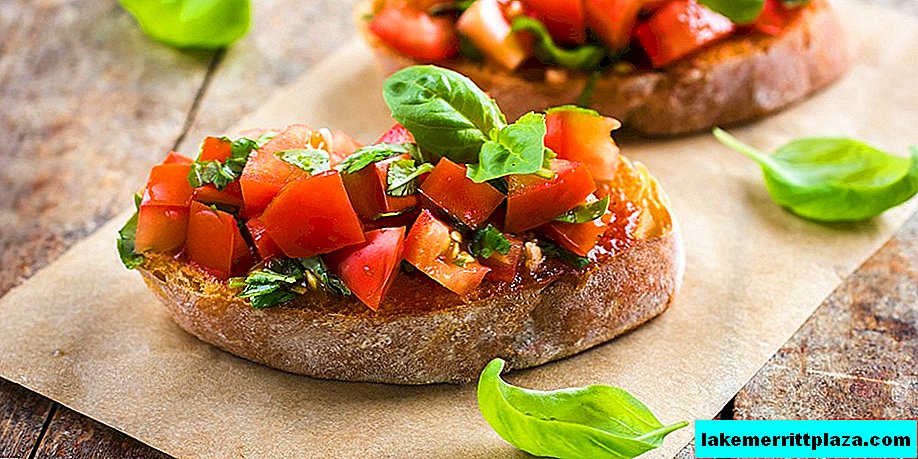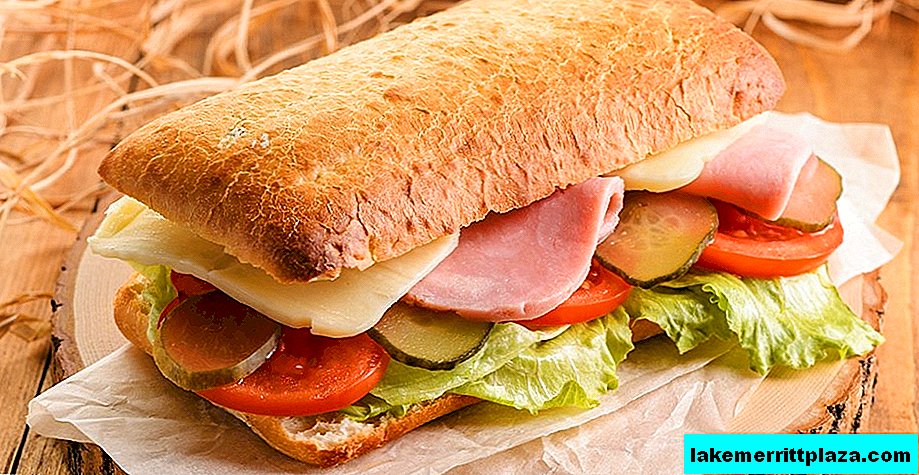From the whole variety of breads in Italy, only a few got to the domestic tables. One of these conquerors of Slavic stomachs was not without reason Ciabatta. This is a typical Italian pastry with crispy crust and large air bubbles. It is they who give the product tenderness, airiness and distinguish it among their "brothers." Ciabatta is a regular on the menu of not only restaurants and cafes, it has also proven itself as a simple recipe for home cooking. And we hasten to share with you all the information that has ever been known about "air" bread.

Data
Ciabatta is a bread that does not have a long history. The official date for the appearance of this baking is September 21, 1982. Although, in fact, her first experimental recipe saw the light in the mid-70s of the last century, when the former athlete Arnaldo Cavallari began his career as a baker. He embarked on the path of a flour product researcher in the hope of inventing a new product that will conquer the world's cuisines.
By a fortunate coincidence, during his search, Cavallari met Raymond Calvelle - the father of the French baguette. He told the novice baker about the use of large amounts of water in the dough to obtain air baking.
From this fateful meeting, Arnaldo, in collaboration with bakers Francesco Cavaron and Arnaldo Cremonesi, began numerous trials. A series of unsuccessful attempts ended with the birth of a real Ciabatta. The first bread was very flat and elongated, like a slipper, which sounded like a ciabatta in the local dialect.

It is interesting that, based on the rules of the Russian language with regard to foreign words, the pronunciation of the name of the bread as "ciabatta" is not entirely true. In Italian, it sounds like "chabatta", which is considered the correct form of using the name of baking. But domestic consumers sympathize with the first, milder version. Therefore, in the article we focused on it.
Modern ciabatta is a light brown pastry slightly sprinkled with flour. Its crust is crispy, and the crumb is loose with a large number of uneven holes of different sizes. They give baking softness and airiness. The color of the cut is white, tending to straw yellow. The aroma is intense, fresh, resulting from prolonged fermentation of the dough. The taste is soft with hints of walnut.
In industrial production, ciabatta prepare the dough under the name "biga" and leave for 18-25 hours to ferment. Then it is cooled by adding water, salt and malt. The finished mass is laid out on a flat surface and allowed to rise for another 45-50 minutes. In the final, the layer is cut into pieces of the required size, which give a characteristic shape and leave for another 15 minutes before baking. Such repeated waiting for the "growth" of the test contributes to the formation of a large number of holes and the tenderness of the crumb inherent in ciabatta.
Varieties
The region of birth and growth of the glory of "air" bread is Liguria. But today, Ciabatta is common throughout Italy and far beyond its borders. The name of the product may vary depending on the territorial dialect. For example, in Spanish Catalonia, he is known by the name "chapata".
The baking structure is also changing in various regions of the republic. So, the ciabatta, created near Lake Como, is famous for its crisp, softness and perfect porosity. Moving through Toscana, Umbria and Marche, we will see how a flour product with a dense crumb and a hard surface turns into a tender, light bread.
- We recommend reading: names and types of bread in Italy

There are many interpretations of the composition of ciabatta. In the capital of Italy, the traditional bread recipe is diversified with the help of olive oil and marjoram. The presence of some components can be determined by its name. In particular:
- Ciabatta integrale is baked from whole grain wheat flour;
- Ciabatta al latte is made with the addition of milk.
So different, it would seem, is such a traditional ciabatta.
Oven recipe
Foreign delicacies have always attracted domestic culinary specialists. Ciabatta is no exception in this regard. And, although the store shelves are full of Italian bread from Russian producers, the desire of housewives to get their own recipe does not fade. We present to your attention a classic option for cooking ciabatta in the oven.
The test preparation process is divided into two stages. On the first of them, leaven is made, on the second - the dough itself.
So, the ingredients necessary for souring:
- Flour from soft wheat varieties of fine grinding - 300 g;
- Water - 300 ml;
- Dry yeast - 2 g.
Components for 2 stages:
- Flour from soft wheat varieties of fine grinding - 600 g;
- Water - 350 ml;
- Dry yeast - 3 g;
- Malt or sugar - 10 g;
- Salt - up to 20 g;
- Whole grain flour for sprinkling.
It is worth mentioning that if you have the opportunity to buy Italian-made flour, then select ciabatta grade 00.
Sourdough in appearance resembles batter for pancakes. To prepare it, we dissolve dry yeast in water heated to 40 degrees (as an alternative, you can take 6 g of fresh yeast). Sift flour into a bowl. Combine everything by pouring liquid into flour.
Knead with a wooden spoon until the mass becomes homogeneous and very soft. Cover the dishes with plastic wrap and leave at room temperature for about 3 hours. After the required time, the leaven will be filled with air bubbles and darken a little.

We pass to stage No. 2. Dissolve dry yeast (or 9 g fresh) and malt (sugar) in warm water. Leave to activate for 15 minutes. Pour the liquid into the sourdough and stir with a wooden spoon. Next, add the sifted flour and salt in portions. When the dough begins to thicken, continue the batch manually for 15-20 minutes until smooth.
Transfer the dough into a bowl, cover with cling film and leave at room temperature (about 25 degrees) for 1 hour. After the time has passed, we send the mass to a work surface sprinkled with whole grain flour. We align in the form of a rectangle, which we fold in half, first along, and then across.
We divide the entire volume into 10 parts (each weight is 150-160 g), form cylinders and lay them out on a working surface. Cover with a film and leave to rise for 1-1.5 hours in a warm place. In the final, the loaves should increase in volume by 2 times.
Gently stretch the dough pieces to the shape characteristic of ciabatta, and transfer to a baking sheet covered with baking paper. We pre-heated the walls to 240-250 degrees (if there is a fan, then to 220-230) we spray the ovens 5-6 times with water using a spray gun. Such preparation will prevent premature crust formation.

Bake "slippers" for 8 minutes, then lower the temperature to 200 (180) degrees and bake another 8 minutes. Next, we continue cooking for another 3-4 minutes, without lowering the temperature, but by opening the oven door. Improvised convection will allow the release of excess steam and will contribute to the formation of a crisp.
Cool the finished baked goods and eat for pleasure.
Recommendations
A few simple recommendations will help you make the process of making homemade ciabatta a little easier:
- Since dough for air bread is saturated with moisture, it is wet and sticks to your hands. Therefore, place a bowl of water near the work surface. Wet your hands a little before tackling the dough. This will prevent sticking.
- Do not worry if the loafs on the baking sheet look flat and unpromising before baking. In the process of heating and evaporation of water, air bubbles are formed that "make" your bread rise.
- Ideally, kneading the dough is better with a planetary mixer or a bread machine. Due to the high humidity, it is inconvenient to work with it manually
- It is better to store finished baked goods in fabric bags for 2-3 days. But the ciabatta can be frozen in the refrigerator and used as necessary, after allowing it to "come to your senses" in the oven for several minutes.
How and what to eat

Despite the apparent simplicity of ciabatta, there are many options for its use. Here's how it is eaten in Italy:
- Cut in half and fry to prepare a bruschetta or toast. Put meat on top, pouring with sauce, or spread paste from liver or game meat.
- Fresh bread is combined with soft cheeses such as gorgonzola, fish and tomatoes.
- Hot sandwiches are popular in the republic. To prepare them, cut the ciabatta in half lengthwise, put slices of pancetta on it and sprinkle with grated cheese. The "fragrant pyramid" is sent to the oven until a crispy cheese crust is formed.
- A traditional version of sandwiches based on “slippers” is a sandwich with omelet and onions between the halves of the bread.
For domestic consumers, Italian pastries will also serve as an interesting substitute for ordinary bread.

Calorie content
Ciabatta is a standard white bread that does not have high nutritional value. The calorie content of 100 g of the product is approximately 289 kcal, which are composed of:
- Protein - 8.6 g (11.9%);
- Fat - 0.4 g (1.25%);
- Carbohydrates - 69.9 g (86.85%).
The main component of bread is flour. And this means that it is a product with a high carbohydrate load. Therefore, it should be consumed in moderation, without forgetting about physical activity.
For a middle-aged adult with a normal physique for burning calories from 100 g of chiabatta, you can:
- Clean in the house 1 hour 40 minutes;
- Run at an average speed of 20 minutes;
- Swim or ride a bike for 30 minutes.
Doctors do not recommend eating white bread for people with high blood sugar.
The article is over, and it follows that to prepare the ciabatta of your dreams, it remains only to take a couple of steps to the kitchen. Live cleanly, love frankly, bake with a smile and remember: "Such delicious slippers as in Italy, you will not try in any country in the world!"





